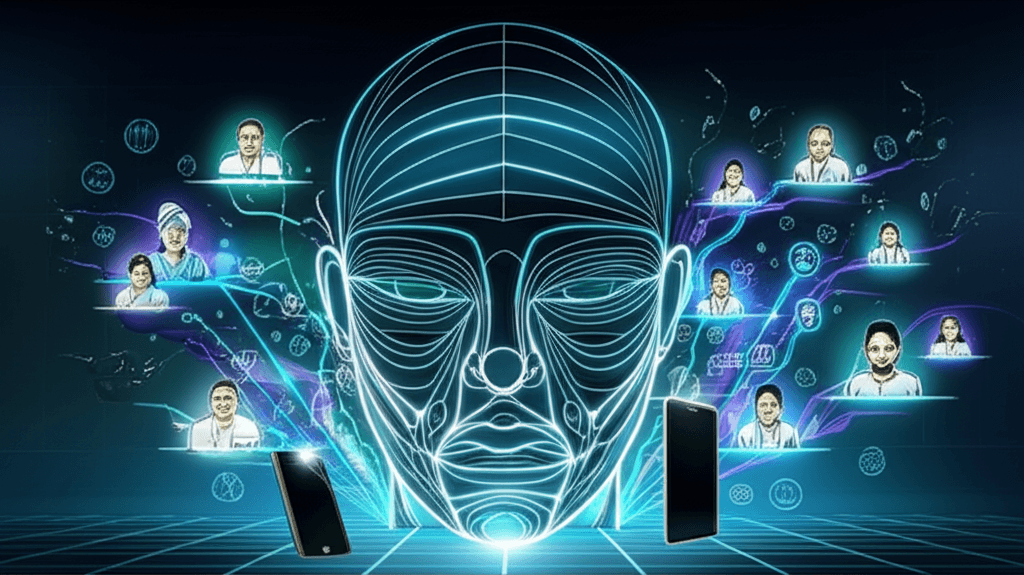Aadhaar AI Face Authentication Explodes: India Hits Record 15.87 Crore Monthly
Aadhaar's AI-powered face authentication surge ensures inclusive, secure access to vital services across India's digital landscape.
July 4, 2025

India's digital identity platform, Aadhaar, has witnessed a monumental surge in usage, with its artificial intelligence and machine learning-powered face authentication feature hitting a record-breaking 15.87 crore transactions in June 2025 alone. This staggering figure represents a more than threefold increase from the 4.61 crore face authentications recorded in the same month of the previous year.[1] The dramatic rise underscores the accelerating adoption of contactless biometric verification across the nation, signaling a significant shift in how Indians access a vast array of services, from government welfare schemes to financial products. The total number of Aadhaar authentication transactions from all methods reached 229.33 crore in June, a 7.8% year-on-year growth, pushing the cumulative number of authentications past 15,452 crore since the system's inception.[2][3][4] This growth is a testament to Aadhaar's deepening integration into the fabric of India's digital economy, serving as a critical pillar for both public service delivery and private sector innovation.
The driving force behind this explosive growth is the AI/ML-based face authentication solution developed in-house by the Unique Identification Authority of India (UIDAI).[2][5] Launched in October 2022, this technology has been rapidly embraced for its convenience and accessibility, especially for individuals who encounter difficulties with fingerprint or iris scans, such as senior citizens and manual laborers.[6][7] The system, which works on both Android and iOS platforms, allows users to verify their identity with a simple face scan, offering a secure, contactless alternative.[2] To date, nearly 175 crore face authentication transactions have been executed, showcasing the public's growing trust in this modality.[1][2] This technology is not merely a convenience; it is a critical enabler of inclusion. By providing an alternative to other biometric methods, it ensures that all segments of the population can access essential services without impediment. The system's underlying AI and machine learning algorithms are designed to be robust, incorporating features like liveness detection to thwart spoofing attempts using static photos or pre-recorded videos, thereby maintaining high-security standards.[8][9]
The application of Aadhaar face authentication spans a wide spectrum of services, highlighting its versatility and importance in modernizing India's service delivery infrastructure. More than 100 entities, including central and state government ministries, financial institutions, oil marketing companies, and telecom providers, are now using this technology.[2][3] It is instrumental in the execution of numerous flagship welfare programs. For instance, it is used to verify beneficiaries for the Pradhan Mantri Jan Arogya Yojana (PM-JAY), the world's largest health insurance scheme, and to authenticate farmers for the PM-Kisan Samman Nidhi scheme, enabling them to receive financial benefits directly.[10] Pensioners are also major beneficiaries, as they can now submit their digital life certificates (Jeevan Pramaan) from home using a smartphone, a significant improvement over the previous requirement to physically visit a disbursing agency.[11][12] In the private sector, financial institutions are leveraging face authentication for electronic Know Your Customer (e-KYC) processes, streamlining customer onboarding and reducing the cost of acquisition.[13] This broad-based adoption across sectors demonstrates the technology's dual utility in enhancing both the ease of living for citizens and the ease of doing business for companies.[2]
The soaring transaction volumes for face authentication are part of a larger trend of increasing reliance on the Aadhaar ecosystem. In June 2025, alongside the record for face scans, Aadhaar e-KYC service also saw substantial use, with over 39.47 crore transactions conducted.[2][13] This service allows for paperless, consent-based identity verification, which is crucial for the banking and non-banking financial services sectors.[13][14] The overall growth in Aadhaar authentications reflects its foundational role as digital public infrastructure, facilitating everything from direct benefit transfers to last-mile banking through the Aadhaar Enabled Payment System (AePS).[15] The consistent growth in these services points to a maturing digital economy where secure and verifiable digital identity is paramount. The in-house development of the AI-powered face authentication technology by UIDAI is a significant achievement for India's domestic tech capabilities and has even garnered accolades, such as the Prime Minister's Award for Excellence in Public Administration under the Innovation category.[16]
In conclusion, the record 15.87 crore AI-powered face authentications in June are a clear indicator of a paradigm shift in identity verification in India.[1] This milestone is not just a statistic but a reflection of a larger movement towards a more inclusive, efficient, and secure digital ecosystem. Driven by a robust, domestically developed AI solution, Aadhaar face authentication is breaking down barriers to access for millions, powering a diverse range of government and private services, and solidifying the Aadhaar platform's role as the bedrock of Digital India. As this technology continues to evolve and its adoption widens, it is poised to further revolutionize service delivery, enhance financial inclusion, and set new benchmarks for the application of artificial intelligence in public-facing services on a global scale. The cumulative total of over 15,452 crore authentications since Aadhaar's beginning is a powerful statement about the scale and impact of this digital identity revolution.[2][3]
Sources
[2]
[7]
[8]
[12]
[13]
[14]
[15]
[16]